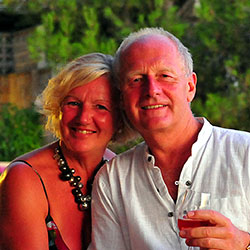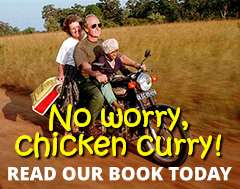Sri Lanka’s capital city is often just an entry point to get you on your way to the white sand beaches, cultural interior or fascinating wildlife – but it has an appeal all of its own.
We’ve collected together ten places to see that we think epitomises the character of Colombo and makes it worthwhile delaying your departure for at least a day.
They’re in no particular order and can all be covered during a cheap two-hour tuk-tuk ride – as long as you don’t mind being covered by exhaust fumes.
A taxi is the cleaner option! You can see the locations as red dots on our map at the end of this article.

Manning Mansions – an architectural throwback to colonialism that you’ll see on your tour in Kumaran Ratnam Rd
We’ve compiled them as much from their architectural interest as their historic value to the history and culture of Colombo and some warrant little more than a drive-by but they will add to your appreciation of historic, cultural and religious knowledge of the city.
We’ve saved our review of two excellent restaurants for another time but you can always get in touch if you can’t wait.
Pagoda Tea Rooms


 Owned by successive generations since 1884, the Pagoda Tea Rooms at its current location in Fort has brewed up for tea planters, civil servants, elegant shoppers and soldiers without seeming to have changed its slightly dusty but evocative ambiance.
Owned by successive generations since 1884, the Pagoda Tea Rooms at its current location in Fort has brewed up for tea planters, civil servants, elegant shoppers and soldiers without seeming to have changed its slightly dusty but evocative ambiance.
Don’t expect the gastronomic delights of a ‘hip’ restaurant but do go there to step backwards through the generations and to immerse yourself in a time when a cup of tea was to be savoured over polite conversation and cake.
Pagoda is a Colombo institution.
Duran Duran filmed several scenes in Pagoda Tea Rooms for their 80’s pop-video ‘Hungry like the wolf’, if you’d like to check it out (and other places in Sri Lanka) here.
The Lighthouse Clock Tower
This striking tower was built on the intersection of Queen’s Road (now Janadhipathi Mawatha) and Chatham Street in Fort in 1857.
The tower not only marked land for sailors and the time for locals but also acted as the point from which all distances were measured in Colombo.
It’s more of a roundabout now than of any significant maritime use – new buildings having obscured its view of the sea.
This has necessitated the construction of a new lighthouse but nevertheless it’s worth a rock around the clock to see it.
The clock, on the other hand, made by English clock-makers, Dent – who also manufactured ‘Big Ben’ – was commissioned for £1,200 in 1814 but its installation was delayed for economic reasons until 1857, when it was finally installed.
It still keeps good time today.
Cargills

You can’t drive through Fort district in Colombo without coming across Cargills iconic building – even if its sign ‘ – GILLS (CEYLON)LTD’ suggests that it’s not as well maintained as it used to be.
This grand edifice in York Street was once the personal residence of Captain Pieter Sluysken, the Dutch military commander of Galle and latterly that of Sir Frederick North, Governor of Ceylon before being redeveloped and turned into a trading emporium.
With expanding trade and evolving demands Cargills involved themselves in everything from fruit and veg through to processed meats and alcohol – with the company branching out by taking the first TGI Fridays franchise in Sri Lanka and opening its own bank.
Temple of Sri Kailawasanathan Swami Devasthanam Kovil

 It’ll take you longer to say the name than it will to see the exterior of the temple in Kew Street.
It’ll take you longer to say the name than it will to see the exterior of the temple in Kew Street.
Nevertheless, tucked down a side street as it is, it’s well worth the visit as the towering gods climb between two towers, adding colour to this otherwise drab street.
The oldest Hindu Temple in Colombo, it is open for visitors at a small charge but having seen many Hindu Temples we were content with just a picture of its colourful exterior.
The Grand Oriental Hotel

The name alone evokes images of wealthy colonials stepping off great ships in the harbour, before riding in a rickshaw followed by their luggage towards the elegant embrace of the hotel.
Once a mansion of a Dutch Governor and subsequently a military barracks, it was later converted to a hotel and opened on the 5th of November 1875, being christened as the ‘Grand Oriental Hotel.’
Queen Elizabeth II and the Duke and Duchess of Kent all graced its hallways in the past but we suspect it no longer has the cachet and comfort they would expect today.
Nonetheless, it still strikes an imposing presence near the waterfront, whilst the bronze rickshaw with its coolie and passenger on the plinth across the street, echo its headier days.
The Red Mosque & Pettah

With its distinctive candy stripe the Red Mosque (or Jami Ul-Alfar Mosque), built in the Pettah district in 1908, is said to have been a distinctive landmark for sailors approaching landfall at Colombo.
Pettah is the thriving bustling district of street bazaars and markets where most of Colombo’s trading is done. Narrow streets and endless stalls and shops cram the busy area near the port.
Commissioned by the Indian Muslim community, It’s architecture is Indo-Saracenic with a dash of Gothic Revival and Neo-classical styles that make it truly distinctive, both inside and out.
Stop off here, throw off your shoes and step inside to what has to be one of the most unusual interiors we’ve found.
Seema Malaka Buddhist Temple

Unlike the Hindu Temple above, we consider worth parting with the small entrance fee to explore the unusual Seema Malaka temple.
Set on a promontory that protrudes into the Beira Lake, the temple is well maintained and distinctive by its pagoda-like pavilions and significant collection of golden seated Buddhas, in a variety of ritual gestures, or Mudras.
Constructed in the late 1800s it was redesigned in 1970 by the renowned Sri Lankan architect Geoffrey Bawa (credited with many of the significant and beautiful buildings you’ll see in Sri Lanka that follow his ‘tropical modernism’ style), when the original ttemple sank slowly into the lake.
It’s not used for worship, more for rest and meditation and its well worth the half an hour or so that you spend there to walk around in peace.
National Museum of Colombo

 To look at the Colombo Museum as it was first known, suggests that it was originally a grand imperial residence or government edifice, rather than being commissioned from the outset as a museum.
To look at the Colombo Museum as it was first known, suggests that it was originally a grand imperial residence or government edifice, rather than being commissioned from the outset as a museum.
The then Governor of Ceylon, Sir William Henry Gregory (whose statue stands in pride of place outside) opened the museum in 1877.
It later housed the crown jewels and thrones of the earlier Sri Lankan Kandyan Kings when the artefacts were eventually returned to Sri Lanka by the British.
It is the largest museum in Sri Lanka. The huge adjacent Banyan tree, to the left of the building is also worthy of some note.
Independence Memorial Hall

Situated in Independence Square in the Cinnamon Gardens District of Colombo, this memorial hall signifies the achieving of independence from British rule in 1948.
An imposing building, it is used by students and couples alike to find some peace and quiet in the city, between state occasions.
Designed by a group of seven or eight architects (!), it nevertheless resembles the style of a ‘Celebration Hall’ of the native Kandyan Kings and is guarded on all corners by ceremonial stone lions and fronted by the statue of D.S. Senanayake, Sri Lanka’s first prime minister. It was he who also stipulated that each of the sixty supporting columns should feature designs of Embekke wood carvings from the 14th century Gampola kingdom.
There is a museum of colonial history in its basement.
Colombo City Town Hall – ‘The White House’

 With little embarrassment, the Colombo Town Hall pays homage to the architecture of its doppelganger, The White House (with the dome of the Capitol Building thrown in for good measure) in Washington DC.
With little embarrassment, the Colombo Town Hall pays homage to the architecture of its doppelganger, The White House (with the dome of the Capitol Building thrown in for good measure) in Washington DC.
In 1922 a competition for an architectural design was launched and of the 32 designs submitted, the White House clone was selected – no doubt to the chagrin of the other competitors!
Other than lamps and fittings, as well as the Council Chamber with its furniture, there is little that hasn’t been ‘modernised’ internally to accommodate the Mayor and his retinue of Councillors.
However, the original external design prevails and creates a suitably grand presence fronting Victoria Gardens (now Viharamahadevi Park).
Royal Colombo Golf Club

Visit here if you fancy a round of golf, or just to see this colonial relic that faithfully preserves the layout, furniture, trophies, photos and traditions of generations past.
If not for the modern cars parked outside, there would be few visual clues to indicate which era you’re in.
Walk through the shed-like hallway with wooden vaulted ceiling, through the anterooms, lounges and restaurant and onto the veranda overlooking an immaculate green, which is being groomed by a retainer with his trusty lawnmower.
Rumour has it that if you haven’t a handicap you’re obliged to play every shot from a tee but we found the Secretary to be most welcoming and accommodating, with no suggestion of such crude restrictions being imposed.
China Town!


 Yes, we know, this is number eleven!
Yes, we know, this is number eleven!
If you hadn’t realised there was a China Town in Colombo, you weren’t far wrong – but don’t hold your breath!
Although not an attraction for travellers necessarily, we were mesmerised by the sheer scale of reclamation near Galle Face beach, instigated by massive Chinese investment in the city.
The landmass of Colombo must be set to double given the huge reclamation works and a new financial, residential and trade hub will emerge from the clouds of sand that are being dredged up and sprayed in opaque fountains along the coastline.
We had several other choices for our top ten slots – the standing Buddha in Cinnamon Gardens, or the Cenotaph War memorial to the dead of two wars – but had to leave them out.
We couldn’t miss mentioning ‘Chinatown’, however, as our ‘ten plus one’ as it will be a changing spectacle for some months and years to come, signifying the rapid evolution of this city.

Colombo is the gateway to somewhere wonderful for your next holiday.

 Let us plan your own inspiring journey to Sri Lanka and more colourful places around the world
Let us plan your own inspiring journey to Sri Lanka and more colourful places around the world
Why not download the TLC World guide brochure or give us a call today on 01202 030443, or simply click ‘enquire’ to submit your own personal itinerary request


























